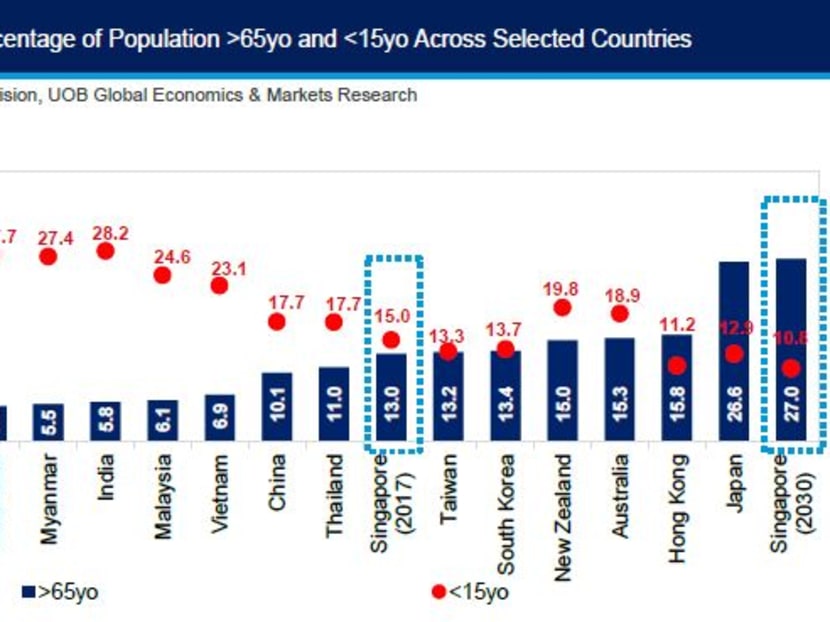Singapore’s 'demographic time bomb' explained, in 5 charts
Singapore is on the cusp of a major demographic milestone, UOB Bank economist Francis Tan pointed out in a research report on Wednesday (Dec 6). Here's a breakdown the report's key observations.
Singapore is on the cusp of a demographic milestone, UOB Bank economist Francis Tan pointed out in a research report on Wednesday (Dec 6).
Come 2018, he wrote, the number of elderly Singaporeans aged 65 and above will, for the first time in the country's modern history, match that of youths aged 15 and below. This trend, while not new, raises a whole host of questions for policymakers, and will have major implications for Singaporeans at large.
Here's a breakdown the report's key observations:
SINGAPORE’S GREYING POPULATION: A CLOSER LOOK

Currently, the proportion of Singaporeans aged 65 and above is 13 per cent, while those aged 15 and below is about 15 per cent. The red and blue lines representing the long-term trend lines of both population segments intersect in 2018, for the first time in the history of modern Singapore.
According to UOB's forecast, Singapore's percentage of seniors will hit 27 per cent by 2030, while the percentage of juniors will decrease to 10.8 per cent - roughly where Japan is today.

The chart above shows a selection of countries ranked according to the proportion of seniors in their population. Japan is the "oldest society in the world" with 26.6 per cent of her population above the age of 65 and 12.9 per cent of the population below the age of 15, wrote Mr Tan.
By 2030, however, the proportion of seniors in Singapore would have doubled to about 27 per cent - a figure higher than those in many Asian countries.

Singapore is already the oldest society in South-east Asia, as the chart above shows. The median age of Singapore's resident population, as of this year, is 40.5 years, compared to the late-20s for other countries in the Association of South-east Asian Nations (Asean).
By 2030, the median age of Singaporeans will be 47 years, compared to 32.9 years for the rest of Asean, according to UOB.

Singaporeans are also projected to live the longest in the region.
In 2018, they are expected to live until the age of 83.3, compared to 71.4 for the rest of the South-east Asia.

Who will support Singapore's increasingly greying population? That responsibility will fall on a smaller group of working adults going ahead.
In 2015, there were 5.7 working adults supporting 1 senior. This number will decrease to 4.3 in 2020. And by 2050, there will just be 1.5 working adults supporting 1 senior.
WHAT CAN BE DONE
- More births, or higher immigration
Long-running efforts to encourage Singaporeans to have more children have not yet yielded much results, with the total fertility rate dropping to its third-lowest level of 1.20 in 2016.
Any attempts to increase immigration at a quicker pace will be tricky, given how the size of the foreign population has been turned into a politically contentious issue.
- Slowing down the exit of existing labour pool
This can be done through encouraging older workers to remain or rejoin the workforce.
Policies, like increasing the CPF contribution rates for older workers or adopting the progressive wage model for lower-wage occupations, have helped to boost job take-ups. The government could also increase the re-employment age from the current 67 to 70.
- Increasing labour productivity
This can be done through an increased usage of automation in production activities, where more economic growth can be created using less labour inputs.
IMPLICATIONS FOR SINGAPORE
With a rapidly ageing population, the Singapore Government will have to increase its spending on healthcare and social services. To do that, it will have to find ways to increase its revenue - hence the recent talk of the need for new taxes as well as higher tax rates.
The Good and Services Tax (GST) could be increased by one percentage point in 2018, and a further one percentage point hike again in 2019.
"Being in the middle of the electoral term, the GST hike is more likely to be implemented early, rather than near the end of the term. Also, the last time the government hiked the GST was way back in 2007," Mr Tan wrote, adding that higher economic growth from this year is expected to cushion against any projected consumption cutbacks that could occur as a result of the GST increase.












